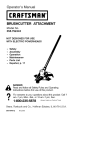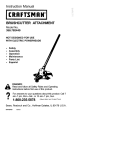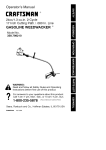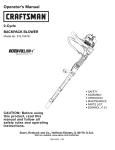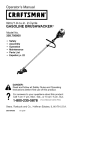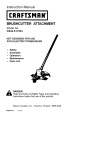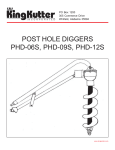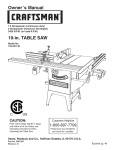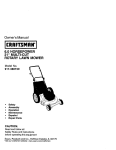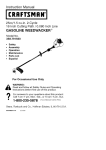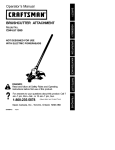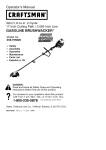Download Craftsman 358.795020 Operator`s manual
Transcript
CRRFTSMRN Operator's Manual 32cc 2-Cycle / Engine 17 Inch Cutting Path / .095 In. Line GASOLINE BRUSHWAOKER ® Model No. 358.795020 Read and follow all Safety Rules and Operating DANGER: Instructions before first use of this product. I_ • For Call answers 7 am-7 1-800-235-5878 Sears, Roebuck 530084630 to your questions this product: pm, Mon-Sat; Sun,about 10 am-7 pm 03/15/99 and Co., Hoffman Estates, IL 60179 USA Warranty Statement Safety Rules Assembly Operation Maintenance Service & Adjustments 2 2 5 9 14 15 FULL ONE YEAR WARRANTY BRUSHWACKER <_ BLADED Storage Troubleshooting Chart Emissions Statement Parts List Spanish Parts and Ordering ON CRAFTSMAN 17 18 18 20 23 Back GAS POWERED TRIMMER. For one year from the date of purchase, when this Craftsman Gas Powered Brushwacker is maintained, lubricated and tuned up according to the operating and maintenance instructions in the Operator's Manual, Sears will repair, free of charge, any defect in materials or workmanship. This warranty excludes the blade, nylon line, spark plug, and air filter, which are expendable parts and become worn during normal use. If this Brushwacker is used for commercial purposes, this warranty applies for only 90 days from the date of purchase. If this Brushwacker is used for rental purposes, this warranty applies for only 30 days from the date of purchase. This warranty applies only while this product is in use in the United States. WARRANTY SERVICE IS AVAILABLE BY RETURNING THE BRUSHWACKER TO THE NEAREST SEARS SERVICE CENTER IN THE UNITED STATES. This warranty gives you specific legal rights, and you may also have other rights which vary from state to state. Sears, Roebuck and Co., D/817 WA Hoffman Estates, IL 60179 DANGER: This power tool can be dangerous! This unit can cause serious injury including amputation or blindness to the operator and others. The warnings and safety instructions in this manual must be followed to provide reasonable safety and efficiency in using the unit. The operator is responsible for following the warnings and instructions in this manual and on the unit. Read the entire Operator's Manual before assembling and using the unit! Restrict the use of this unit to persons who read, understand, and follow the warnings and instructions in this manual and on the unit. Never allow children to use this unit. WARNING: instructions. in serious Follow all warnings and Failure to do so can result injury. SAFETY NOTICE Exposure to vibrations through prolonged use of gasoline powered hand tools could cause blood vessel or nerve damage in the fingers, hands, and joints of people prone to circulation disorders or abnormal swellings. Prolonged use in cold weather has been linked to blood vessel damage in otherwise healthy people. If symptoms occur such as numbness, pain, loss of strength, change in skin color or texture, or loss of feeling in the fingers, hands or joints, discontinue the use of this tool and seek medical attention. An anti-vibration system does not guarantee the avoidance of these problems. Users who operate power tools on a continual and regular basis must monitor closely their physical condition and the condition of this tool. contacting the left hand side of coasting blade with material already cut. Stop coasting blade by contact with cut material __® DANGER: Blade canthrust violently away frommaterial itdoesnotcut. Blade thrust cancause amputation of armsorlegs.Keep people andanimals50feet(15meters) away. OPERATOR SAFETY • Dress properly. Always wear safety glasses or similar eye protection when operating, or performing maintenance on your unit. (Safety glasses are available.) Always wear face or dust mask if operation is dusty. Always wear heavy, long pants, long sleeves, boots, and gloves. Do not go barefoot or wear sandals. • Secure hair above shoulder length. Secure or remove loose clothing and jewelry or clothing with loosely hanging ties, straps, tassels, etc. They can be caught in moving parts. • Being fully covered also helps protect you from debris and pieces of toxic plants thrown by spinning line. • Stay Alert. Do not operate unit when you are tired, ill, or under influence of alcohol, drugs, or medication. Watch what you are doing; use common sense. • Wear hearing protection if you use the unit for more than 1-1/2 hours per day. • Never start or run the engine inside a closed room or building. Breathing exhaust fumes can kill. • Keep handles free of oil and fuel. • Always use the handlebar and a properly adjusted shoulder strap with a blade. See "Assembly." UNIT/MAINTENANCE SAFETY ALWAYS WEAR I THROWN OBJECTS Eye I Protection I it Leg , I / m m L_uaras * Boots WARNING: Trimmer line can throw objects violently. You can be blinded or injured. Wear eye and leg protection. _d WARNING: Zone Hazard zone for thrown objects. Blade/Trimmer line can throw objects violently. Others can be blinded or injured. Keep people and animals 50 feet (15 meters) away. WARNING: as a fastening WARNING: Do not use trimmer • Look for and replace damaged or loose parts before each use. Look for and repair fuel leaks before use. Keep unit in good working condition. • Throw away blades that are bent, warped, cracked, broken, or damaged in any other way. Replace trimmer head parts that are cracked, chipped, broken, or damaged in any other way before using the unit. • Maintain the unit according to recommended procedures. Keep the blade sharp. Keep the cutting line at the proper length. head device for the blade. The blade continues to spin after throttle is released or, engine is turned off. The coasting blade can throw objects or seriously cut you if accidentally touched. Stop the blade by 3 • Useonly.095" (2.4 ram} diameter Craftsman u_brand line. Never use wire, rope, string, etc. • install required shield properly before using the unit. Use the metal shield for all metal blade use. Use the plastic shield for all line trimmer use, • Use only specified blade or trimmer head; make sure it is proper_y installed and securely fastened. • Never start engine with clutch shroud removed. The clutch can fly off and cause serious injury. • Be sure blade or trimmer head stops turning when engine idles. • Disconnect the spark plug before performing maintenance (except carburetor adjustments). • Make carburetor adjustments with the lower end supported to prevent the blade or trimmer line from contacting any object, Hold the unit by hand; do not use the shoulder strap for support. • Keep others away when making carburetor adjustments. • Use only recommended Craftsman accessories and replacement parts. • Have all maintenance and service not explained in this manual performed by a Sears Service Center. FUEL SAFETY • • • • • • • • Mix and pour fuel outdoors. Keep away from sparks or flames. Use a container approved for fuel. Do not smoke or allow smoking near fuel or the unit or while using the unit. Wipe up all fuel spills before starting engine. Move at least 10 feet (3 meters) away from fueling site before starting engine. Stop engine and allow it to cool before removing fuel cap. Empty the fuel tank before storing the unit. Use up fuel left in the carburetor by starting the engine and letting it run until it stops. • Store unit and fuel in an area where fuel vapors cannot reach sparks or open flames from water heaters, electric motors or switches, furnaces, etc. CUTTING SAFETY • Inspect the area to be cut before each use. Remove objects (rocks, broken glass, nails, wire, string, etc.) which can be thrown or become entangled in the blade or trimmer head. • Keep others including children, animals, bystanders, and helpers at least 50 feet (15 meters) away. Stop the engine immediately if you are approached. • Always keep engine on the righthand side of your body. • Hold the unit firmly with both hands. • Keep firm footing and balance. Do not overreach. • Keep blade or trimmer head below waist level. • Do not raise engine above your waist. • Keep all parts of your body away from blade, trimmer head, and muffler when engine is running. • Cut from your right to your left. • Use only for jobs explained in this manual. TRANSPORTING AND STORAGE • Stop the unit before carrying. • Keep muffler away from your body. • Allow engine to cool and secure unit before storing or transporting it in a vehicle. • Empty the fuel tank before storing or transporting the unit. Use up fuel left in the carburetor by starting the engine and letting it run until it stops. • Store unit and fuel in an area where fuel vapors cannot reach sparks or open flames from water heaters, electric motors or switches, furnaces, etc. • Store unit so the blade or line limiter cannot accidentally cause injury. The unit can be hung by the tube. • Store unit out of reach of children. CARTON CONTENTS Check carton contents against thefollowing list. Model: WARNING: If received assembled, repeat all steps to ensure your unit is properly assembled and all fasteners are secure. 358.795020 • • • • • Engine 2 tube mounting screws 2 tube mounting nuts 2 handlebar screws 4 blade shield screws • • • • 1 1 1 1 cupped washer large nut for installing blade long hex wrench short hex wrench • • • • 1 1 1 1 upper handlebar cover bracket shield for use with blades shield for use with trimmer head trimmer head • • • • • 1 1 1 1 1 shoulder strap with warning weed blade brush blade handlebar container of oil ACTUAL ASSEMBLY SIZE TOOLS REQUIRED In addition to the 2 hex wrenches provided with your unit, you will need an adjustable wrench. ATTACHING NOTE: THE Illustrations TUBE within this section will help in identifying the assembly steps. Be sure to read each section and review the illustrations before you begin. Align the engine with the fuel cap up as shown below. NOTE: A drive shaft is located in the center of the tube. Make sure this shaft does not fall out of the tube. Dirt on the shaft will significantly reduce the life of the unit. If this shaft falls out, clean, relubricate, and re-install. • Using a hex wrench, insert the 2 tube mounting screws and nuts as illustrated. Keep loose at this time; you will tighten them during a later step. HARDWARE Tube Mounting Screw Cupped Washer Blade Shield Screw Large nut for installing Blade _ • Some units may include a plastic cover over the end of the tube. If your unit includes a cover, remove it by pulling the tab. • Pull about 1/2 inch of the drive shaft out of the inside of the tube. _' C"_j '_ Tube Mounting Nut 1/2 Handlebar Screw _Pull Examine parts for damage. Do not use damaged parts. NOTE: If you need assistance or find that parts are missing or damaged, call ] -800-235-5878. It is normal for the fuel filter to rattle in about Tube inch from tube NOTE: The square end of the drive shaft fits inside a square hole in a shaft inside the engine. Look inside end of engine and you will see the square hole in shaft. Align square end of the drive shaft with the square hole. the empty fuel tank. Finding fuel or oil residue on muffler is normal due to carburetor adjustments and testing done by the manufacturer. 5 NOTE: Theendofthetubehasa groove, orindention, thataligns witha ridge, orraised area, intheslotinthe engine. Locate thegroove andridge. • Alignthegroove inthetubewiththe ridgeinside opening intheengine. Insert thetubeintotheopening. " _ Ridge _ TRIMMER HEAD Groove WEED BLADE • Firmly push the tube into the engine until it will no longer go into opening. • Now tighten the screws, using one of the hex wrenches provided with unit. ATTACHING O BRUSH BLADE THE HANDLEBAR ASSEMBLY FOR USE WITH A TRIMMER HEAD NOTE: Unlike a bicycle, the handgrips on the handlebar point toward the front instead of toward the back. • Locate decal on handlebar. Align handlebar so inner arrows point to engine. Make sure the wire assembly is not wrapped around the tube. • Set handlebar on mounting bracket. Align mounting bracket between the outer arrows on the handlebar decal. • Position bracket cover over the han- HEAD TRIMMER dlebar. Again make sure the bracket is between the arrows. • Insert screws and tighten securely. • Insert wire assembly into the groove in the bottom of the foam grip. Bracket Foam Grip Wire Assembly CONFIGURING Cover NOTE: If your unit has been assembled for brushblade use, refer to the section "ASSEMBLY INFORMATION FOR USING YOUR UNIT WITH A BRUSHBLADE" and Screw reverse the steps to remove the metal shield and blade before you mount the plastic shield and trimmer head. ATTACHING THE PLASTIC AND TRIMMER HEAD Handlebar Mounting Bracket SHIELD WARNING: The shield must be properly installed. The shield provides partial protection from the risk of thrown objects to the operator and others and is equipped with a line limiter which cuts excess line to the proper length. The line limiter (on underside of shield) is sharp and can cut you. • Remove wing nut from shield. • Insert bracket into slot on shield. • Pivot shield until bolt passes through hole in bracket. YOUR UNIT You can configure your unit using a cutting head or weed blade for grass and light weeds, or a brush blade for cutting saplings and similar size material. Go to the section for the desired configuration and follow the instructions for assembling your unit. • Tighten the wing nut securely. 6 • Ifyourunithasaplastic cover onthe threaded shaft, remove thecover. • Make suredustcupandretaining washer arepositioned ongearbox as shown before installing trimmer head. Slot verse the steps to remove the plastic shield and trimmer head before you mount the metal shield and blade. Store these parts for future use. Never use the trimmer head with the metal blade installed. ASSEMBLY Wing Nut Gearbox S Shield Dust Cup _(..___ Retaining Washer OF THE METAL SHIELD DANGER: The metal shield must be properly installed on the tool anytime the tool is used with the blade. The forward top of the metal shield helps to reduce the occurrence of blade thrust which can cause serious injury such as amputation to the operator or bystanders. Failure to install the shield in the position shown can result in serious injury to the operator. The length of the shield must be aligned with the length of the tube. The blade is sharp and can cut you. Be sure to wear gloves while working with blades. • Place the metal shield under the ,_,_ NOTE: Make sure all parts are properly installed as illustrated before installing the trimmer head. • Align hole in the dust cup with the hole in the side of the gearbox by rotating the dust cup. • Insert a hex wrench into the aligned holes. This will keep the shaft from turning while tightening the trimmer head. gearbox, and align the screw holes. • Insert the 4 mounting screws through the bottom of the shield. Thread them into the gearbox. Tighten evenly and securely with one of the hex wrenches provided. Gearbox Hex Wrench _ Shield \ • While holding the hex wrench in position, thread trimmer head onto the shaft and tighten until secure. • Remove the hex wrench. ASSEMBLY BLADE Mounting Screws _ FOR USE WITH A ASSEMBLY I OF THE METAL BLADE WARNING: Do not use any blades or fastening hardware other than those illustrated in this manual. These items must be Craftsman parts and installed as shown below. Failure to use proper parts can cause the blade to fly off and seriously hurt you or others. WEED BLADE O NOTE: The weed blade is reversible; it can be installed with either side facing up. The brushblade must be installed with the correct side facing up. The correct side will be marked on the blade. If BRUSH BLADE NOTE: If your unit has been assembled for trimmer head use, refer to the section "ATTACHING THE PLASTIC SHIELD AND TRIMMER HEAD" and re- you are re-installing an older blade and the writing has worn off, install it using the following illustration as a guide. 7 • Install the blade nut by threading onto the shaft counterclockwise. Top view of blade NOTE: Make sure all parts are in place as illustrated, and the blade is sandwiched between the dust cup and the retaining washer. There should be no space between the blade and the dust cup or the retaining washer. • Align hole in the dust cup with the hole in the side of the gearbox by rotating the blade. • Insert a hex wrench into aligned holes. This will keep the shaft from turning while tightening the blade nut. Teeth on blade poir in this direction WARNING: Do not use any blades or fastening hardware other than the washers and nuts illustrated. These items must be Craftsman parts and installed as shown. Failure to use proper parts can cause the blade to fly off and seriously hurt you or others. Hex Wrench _ • If your unit has a plastic cover on the threaded shaft, remove the cover. • Remove the retaining washer from the gearbox; leave the dust cup on the gearbox. Retaining Washer _ • Tighten blade nut firmly with a wrench while holding hex wrench in position. • Remove the hex wrench. • Turn blade by hand. If blade binds against the shield or appears to be uneven, the blade is not centered, and you must reinstall the blade. NOTE: To remove blade, insert hex wrench into aligned holes. Unthread nut and remove parts. Be sure to store parts and instructions for future use. @ • Install the blade between the dust cup and retaining washer as shown in the following illustration. Make sure the raised part of the retaining washer is facing the gearbox, and the raised area fits into the hole in the center of the blade Clamp ASSEMBLY _" it OF SHOULDER STRAP WARNING: Adjust shoulder strap and handlebar before starting the engine. • Rotate clamp to the upright position; tighten T-handle securely. • Try on shoulder strap and adjust for fit and balance before starting engine or beginning a cutting operation. • Insert your right arm and head through the shoulder strap and allow it to rest on your left shoulder. Make sure the danger sign is on your back and the hook is to the right side of your waist. • Adjust the strap, allowing the hook to be about 6 inches below the waist. • Fasten the strap hook to the clamp. Lift the tool to the operating position. NOTE: Unclip the shoulder strap from the clamp before starting the unit. Blade Retaining/_ Washer Cupped//4______._ Washer Nut '_ • Place the cupped washer onto the shaft. Make sure the cupped side of the washer is toward the blade as shown. 8 KNOW YOURBRUSHWACKER READ THIS OPERATOR'S MANUAL AND SAFETY RULES BEFORE OPERATING YOUR UNIT. Compare the illustrations with your unit to familiarize yourself with the location of various controls and adjustments. Save this manual for future reference. Control Handle j _ Starter j_qJ=_ Handle _, Choke Primer /' <.-_ " :b\_-,,. Lever .... _<,'%__ Bulb Muffler Switch One® ON/STOP SWITCH The On/Stop switch is located on the control handle and is used to stop the engine. Push the switch to the stop position to stop the unit. THROTTLE LOCKOUT er pulls on the starter rope. Activate the primer bulb by pressing it and allowing it to return to its original form. CHOKE The choke helps to supply fuel to the carburetor during starting. This allows you to start a cold engine. Activate the choke by moving the choke lever to the Full position. After the engine has started, move the choke to the Off position. The Throttle Lockout prevents the throttle trigger from being depressed. PRIMER BULB The primer bulb removes air from the fuel lines and fills them with fuel. This allows you to start the engine with fewBEFORE STARTING ENGINE IMPORTANT WARNING: Be sure to read the fuel information in the safety rules before you begin. If you do not understand the safety rules, do not attempt to fuel your unit. Call 1-800-235-5878. FUELING Experience indicates that alcohol blended fuels (called gasohol or using ethanol or methanol) can attract moisture which leads to separation and formation of acids during storage. Acidic gas can damage the fuel system of an engine while in storage. ENGINE This engine is certified to operate on unleaded gasoline. Before operation, gasoline must be mixed with a good quality 2-cycle air-cooled engine oil. We recommend Craftsman brand oil. To avoid engine problems, empty the fuel system before storage for 30 days or longer. Drain the gas tank, start the engine and let it run until the fuel lines and carburetor are empty. Use fresh fuel next season. Mix gasoline and oil at a ratio of 40:1 (A 40:1 ratio is obtained by mixing 3.2 ounces of oil with 1 gallon of unleaded gasoline). DO NOT USE automotive oil or boat oil. These oils will cause engine damage. When mixing fuel, follow instructions printed on container. Never use engine or carburetor cleaner products in the fuel tank or permanent damage may occur. See the STORAGE section for additional information. 9 STOPPING YOUR ENGINE Starter _,. Handle "_ • Move the On/Stop switch to the STOP position. • If engine does not stop, move choke to the Full Choke position. on/Stop Switch off On Throttte Trigger STARTING Choke YOUR ENGINE NOTE: A special feature called tile "Throttle Lock" holds the throttle trigger in the depressed position for you during starting. • Lock the throttle trigger into the starting postion by first pressing the lockout lever on the top of the control handle. While the lockout lever is depressed, squeeze and hold the throttle trigger. Lock Button _/ Throttle Trigger Lockout Lever _C__'_Z_,_ • Before releasing the throttle trigger, press the lock button. While this button is still depressed release the throttle trigger. NOTE: This should allow the throttle trigger to remain in the depressed position for starting. You may want to practice this a few times before you first start the unit. • DO NOT squeeze throttle trigger during starting; otherwise, it will be necessary to reset the throttle lock. COLD ENGINE OR WARM ENGINE AFTER RUNNING OUT OF FUEL WARNING: The blade or trimmer head will turn while starting the engine. Avoid any contact with the muffler. A hot muffler can cause serious burns. • Rest engine and shield on ground, supporting trimmer head off ground. • Move the switch to the on position. • Slowly press the primer bulb 6 times. • Move choke to Full Choke position. Primer Bulb • Set the throttle trigger in the starting postion using the throttle lock feature. Keep throttle trigger in the starting position until the engine runs smoothly. • Pull starter rope sharply until engine attempts to run or 5 times. • Move choke lever to Half Choke. • Pull starter rope sharply until engine runs, but no more than 6 pulls. NOTE: If the engine has not started after 6 pulls (at half choke), check to make sure the choke lever is in the proper position. Then, move the choke to the Full Choke position and press the primer bulb 6 times; pull the starter rope 2 more times. Move the choke lever to Half Choke and pull the starter rope until the engine runs, but no more than 6 more pulls. If the engine still has not started, it is probably flooded. Proceed to "Starting a Flooded Engine." • Allow the engine to run 10 seconds, then move choke lever to Off Choke. Let the engine run 30 more seconds at Off Choke before releasing the throttle lock. Release throttle lock by squeezing and releasing the trigger. STARTING A WARM ENGINE • Move the switch to the on position, and choke to Half Choke position. • Set the throttle trigger in the starting postion using the throttle lock feature. Keep throttle trigger in the starting position until the engine runs smoothly. • Pull starter rope sharply until engine runs, but no more than 5 pulls. • Allow engine to run 15 seconds, then move the choke lever to Off Choke. NOTE: If engine has not started, pull starter rope 5 more pulls. If engine still does not run, it is probably flooded. 10 DIFFICULT STARTING OR STARTING A FLOODED ENGINE Flooded engines can be started by moving choke lever to Off Choke; then, pull the rope to clear the engine of excess fuel. This could require pulling the starter handle many times depending on how badly the unit is flooded. If the unit still doesn't start, refer to TROUBLESHOOTING chart or call 1-800-235-5878. OPERATING POSITION Control Handle in Right Hand Position Operating Clip shoulder strap onto clamp and stand to operating position. • Arms extended with hands holding the handlebar grip. • Right hand holding control handle, with fingers on throttle trigger. • Engine below waist level. • Shoulder strap pad centered on left shoulder. • Danger sign centered on your back. • Full weight of tool on left shoulder. • Without operator bending over, the blade or semi-automatic head is near and parallel to the ground and easily contacts material to be cut. OPERATING INSTRUCTIONS FOR USE WITH TRIMMER HEAD Bring the engine to cutting speed before entering the material to be cut. Do not run engine at a higher speed than necessary. The cutting line will cut efficiently when engine is run at less than full throttle. At lower speeds, there is less engine noise and vibration. The cutting line will last longer and will be less likely to "weld" onto the spool. If the trimmer head does not turn when the engine is in operation, make sure the drive shaft housing is properly seated in engine shroud. Always release the throttle trigger and allow the engine to return to idle speed when not cutting. To stop engine: • Release the throttle trigger. • Move the On/Stop switch to the STOP position. • If engine does not stop, move choke to the Full Choke position. ADVANCING THE TRIMMER LINE The trimmer line will advance approximately 2 in. (5 cm) each time bottom of trimmer head is tapped on the ground with the engine running at full throttle. The most efficient line length is the maximum length allowed by line limiter. Always keep the shield in place when the tool is being operated. To Advance Line: • Operate the engine at full throttle. • Hold the trimmer head parallel to and above the grassy area. • Tap bottom of trimmer head lightly on ground one time. Approximately 2 in. (5 cm) of line will be advanced with each tap. The line limiter on the shield will cut line to the correct length. "_¥ _C__:<" .,he Umiter Always tap the trimmer head on a grassy area. Tapping on surfaces such as concrete or asphalt can cause excessive wear to the trimmer head. If line is worn down to 2 in. (5 cm) or less, more than one tap will be required to obtain the most efficient line length. WARNING: Use only .095" (2.4 mm) diameter line. Other sizes of line will not advance properly and can cause serious injury. Do not use other materials such as wire, string, rope, etc. Wire can break off during cutting and become a dangerous missile that can cause serious injury. CUTTING METHODS WARNING: Use minimum speed and do not crowd the line when cutting around hard objects (rock, gravel, fence posts, etc.), which can damage the trimmer head, become entangled in the line, or be thrown causing a serious hazard. 11 • Thetipofthelinedoes thecutting. Youwillachieve bestperformance and minimum linewear bynotcrowding lineintothecutting area. Theright and wrong ways areshown below. TipoftheLine I Line Crowded into Does TheCutting Work Area Right :"_:_'-"_,1 Wrong = " posts, monuments, etc. This technique increases line wear. Scalping MOWING '" • The line will easily remove grass and weeds from around walls, fences, trees and flower beds, but it also can cut the tender bark of trees or shrubs and scar fences. To help avoid damage especially to delicate vegetation or trees with tender bark, shorten line to 4-5 in. (10-13 cm) and use at less than full throttle. • For trimming or scalping, use less than full throttle to increase line life and decrease head wear, especially: • During light duty cutting. • Near objects around which the line can wrap such as small posts, trees or fence wire. • For mowing or sweeping, use full throttle for a good clean job. WARNING: Always wear eye protection. Never lean over the trimmer head. Rocks or debris can ricochet or be thrown into eyes and face and cause blindness or other serious injury. TRIMMING - Hold the bottom of the trimmer head about 3 in. (8 cm) above the ground and at an angle. Allow only the tip of the line to make contact. Do not force trimmer line into work area. Trimming il > - Your trimmer is ideal for mowing in places conventional lawn mowers cannot reach. In the mowing position, keep line parallel to ground. Avoid pressing head into ground as this can scalp ground and damage tool. Mowing SWEEPING - The fanning action of rotating line can be used for a quick and easy clean up. Keep line parallel to and above the surfaces being swept and move the tool from side to side. _/- _.z OPERATING INSTRUCTIONS FOR USE WITH A BLADE • Blade Thrust is a reaction that only occurs when using a bladed unit. This reaction can cause serious injury such as amputation. Carefully study this section. It is important that you understand what causes blade thrust, how you can reduce the chance of its occurring, and how you can remain in control of unit if blade thrust occurs. • WHAT CAUSES BLADE THRUST Blade Thrust can occur when spinning blade contacts an object that it does not cut. This contact causes blade to 3 in. (8 cm) ;'_"_.":'_"_=--,_ 2 2, Above Ground _i_l_._,_" _" stop for an instant and then suddenly move or "thrust" away from object that was hit. The "thrusting" reaction can be violent enough to cause operator to be propelled in any direction and lose control of unit. The uncontrolled unit SCALPING - The scalping technique removes unwanted vegetation. Hold bottom of trimmer head about 3 in. (8 cm) above ground and at an angle. Allow tip of line to strike the ground around trees, 12 cancause serious injury ifblade con- • Keep feetcomfortably spread apart tacts operator orothers. andbraced forapossible sudden, • WHEN BLADE THRUST OCCURS. rapid thrust ofunit.Donotoverreach. Blade thrust canoccur without warn- Keep firmfooting andbalance. ingiftheblade snags, stalls, or • Keep blade below waistlevel. Itwill beeasier tomaintain control ofunit. binds. Thisismore likelytooccur in areas where itisdifficult toseethe • Donotraise theengine above your material being cut.Byusing theunit waistastheblade cancome dangerproperly, theoccurrence ofblade ously close toyourbody. thrust willbereduced andtheopera- • Donotswing theunitwithsuchforce torwillbelesslikely tolosecontrol. thatyouareindanger oflosing your balance. Bring theengine tocutting speed beforeentering thematerial tobecut. Iftheblade doesnotturnwhen you squeeze thethrottle trigger, make sure thetubeisfullyinserted intoengine. Always release thethrottle trigger and allow engine toreturn toidlespeed • Cutonlygrass, weeds, andwoody whennotcutting. Theblade should not brush upto1/2inchindiameter with turnwhile theengine isrunning atidle. weed blade, andupto2inches with Iftheblade turnsatidle,donotuse brush blade. Donotletblade contact yourunit.Refer totheCarburetor admaterial itcannot cutsuch asstumps, justment section orcontact yourSears Center. rocks, fences, metal, etc.,orclusters Service ofhard, woody brush witha diameter • Maintain goodfirmfooting whileusgreater thanthatrecommended. ingtheunit.Dothisbyplanting feet • Useasharp blade. Adullblade is firmlyinacomfortable apart position. more likelytosnagandthrust. • Cutwhileswinging theupper partof • Outonlyatfullthrottle. Theblade will yourbody fromrighttoleft. havemaximum cutting power andis • Asyoumove forward tothenext lesslikelytobindorstall. areatocut,besuretomaintain your • "Feed" theblade deliberately andnot balance, andfooting. toorapidly. Theblade canthrust 10o'clock _ away ifitisfedtoorapidly. Cut using the 8o'clock _ _'l_l_"}" _ • Cutonlyfromyourright toyourleft. to10o'clock position of._,,y ]1 _[ Swinging unitinthesame direction as the blade 8 o,clock _._ _ blade spinincreases cutting action. WARNING: The operator or others • Usetheshoulder strapandkeep a firmgripontheunitwithbothhands. must not try to clear away cut material Aproperly adjusted shoulder strap with the engine running or the blade willsupport theweight oftheunit, turning to avoid serious injury. Stop enfreeing yourarmsandhands tocon- gine and blade before removing matetrolandguide thecutting motion. rials wrapped around blade or tube. 13 MAINTENANCE SCHEDULE CARE & MAINTENANCE Check for Loose fasteners TASK Before each use Check for damaged or worn parts Clean unit and labels Before each use Clean air filter Every 5 hours of operation After each use Inspect and clean spark arrestor Every 25 hours of operation Replace Yearly spark plug GENERALRECOMMENDATIONS The warranty on this unit does not cover items that have been subjected to operator abuse or negligence. To receive full value from the warranty, the operator must maintain unit as instructed in this manual. Various adjustments will need to be made periodically to properly maintain your unit. CHECK FOR FASTENERS • • • • • WHEN TO PERFORM and parts LOOSE AND PARTS A dirty air filter decreases engine performance and increases fuel consumption and harmful emissions. Always clean after every 5 hours of operation. • Clean cover area around it to keep dirt and debris from falling into carburetor chamber when cover is removed. • • • • Spark Plug Boot Air Filter Housing Screws Assist Handle Screws Shield CHECK WORN FOR DAMAGED PARTS Remove parts as illustrated. Wash the filter in soap and water. Allow filter to dry= Replace parts, making sure the filter is seated completely. Lws OR Refer replacement of damaged/worn parts to your Sears Service Center. • On/Stop Switch - Ensure On/Stop switch functions properly. Move switch to "Stop." Make sure engine stops; then restart engine and continue. • Fuel Tank - Discontinue use if fuel view of Air Filter Cover Air Filter JBack tank shows signs of damage or leaks. • Shield - Discontinue use of unit if shield is damaged. CLEAN UNIT & LABELS • Clean the unit using a damp cloth with a mild detergent. • Wipe off unit with a clean dry cloth. CLEAN AIR FILTER Do not clean filter in gasoline or other flammable solvent to avoid creating a fire hazard or producing harmful evaporative emissions. INSPECT ARRESTOR AND CLEAN SPARK (if equipped) As tile unit is used, carbon deposits build up on the muffler and spark arrestor screen, and must be removed to avoid creating a fire hazard or affecting engine performance. Remove the spark arrestor screen from the muffler and clean. Replace spark arrestor screen if breaks occur. 14 REPLACE SPARKPLUG Replace the spark plug each year to ensure the engine starts easier and runs better. Set spark plug gap at .025 in. Ignition timing is fixed and nonadjustable. • Twist, then pull off spark plug boot. REPLACING THE LINE WARNING: Trimmer head parts that are chipped, cracked, broken, or damaged in any other way can fly apart and cause serious injury. Do not use. Replace damaged parts before using unit. • Press the tab on the side of the trim- • Remove spark plug from cylinder and discard. • Replace with Champion CJ-8Y spark plug and tighten with a 3/4 in. socket wrench (10-12 ft.-Ibs). • Reinstall the spark plug boot. • With your finger between the lines, wrap the lines evenly and and firmly around the spool in the direction of the arrow on the spool • Position the lines in the guide slots. mer head and twist the lock ring. • Remove the lock ring and tap button. Tab L_J //" "-_7._ Lock Ring Tap Button • Pull the spool out of the trimmer head. Remove any remaining line. • Clean dirt and debris from all parts. Replace spool if it is worn or damaged. • Replace with a pre-wound spool, or replace line using two 20 foot lengths of .095 inch (2.4 mm) diameter Craftsman _R_ line. • Insertthe ends ofthe lines through exit holes in the sides ofthe trimmer head. • Place the spool in the trimmer head. • Make sure the lines are not caught between the rim of the spool and the wall of the trimmer head. • Reinstall the tap button and lock ring onto the trimmer head. • Align the lock ring over the catches on the trimmer head. Push the ring down and turn until the catches lock into place. • When installing new line on an existing spool, insert 1/16" of the end of each line into the anchoring holes in the bed of the spool. __)) Catch _ch Anchoring • Make sure the lock ring is securelyfastened by pulling on it and twisting in both directions. WARNING: All catches must be fastened and the lock tab latched in the Arrow lock ring. If installed incorrectly, the lock ring can fly off and become a dangerous missile. • Pull line extending 15 from trimmer head. CARBURETOR ADJUSTMENT WARNING: The trimmer head or blade will be spinning during most of this procedure. Wear protective equipment and observe all safety precautions. After making mixture adjustments, recheck idle speed. Carburetor adjustment is critical and if done improperly can permanently damage the engine as well as the carburetor. If you require further assistance or are unsure about performing this procedure, call our customer assistance help line at 1-800-235-5878. Old fuel, a dirty air filter, a dirty fuel filter, or flooding may give the impression of an improperly adjusted carburetor. Check these conditions before adjusting the carburetor. The carburetor has been carefully set at the factory. Adjustments may be necessary if you notice any of the following conditions: • Engine will not idle. See "Idle Speed" under adjusting procedure. • Engine dies or hesitates instead of accelerating. See "Acceleration Check" under adjusting procedure. • Loss of cutting power. See "Mixture Adjustment" under adjusting procedure. There are three adjustment screws on the carburetor. The low speed adjustment screw is marked with the letter L, and the high speed adjustment screw is marked with the letter H. The third screw is the idle adjustment screw. L Screw Idle Adjustment CARBURETOR PRESETS When making carburetor preset adjustments, do not force plastic limiter caps beyond stops or damage will occur. If carburetor presets are not needed, proceed to "Adjusting Procedure, Idle Speed." To adjust presets: • Turn both mixture screws counter- clockwise to the midpoint between the limiter cap stops. • Turn the idle speed screw clockwise until it stops. Now turn counterclockwise 4-1/2 turns. • Start motor, cut grass for 3 minutes, and proceed to the adjustment section. If engine does not start, refer to troubleshooting chart or call 1-800-235-5878. • If engine performance is acceptable at the preset positions, no further adjustment is necessary. ADJUSTING Idle Speed PROCEDURE Adjustment Allow engine to idle. Adjust speed until engine runs without stalling. • Allow engine to idle. Be sure trimmer line is extended to the maximum length allowed by the line limiter. • Adjust idle speed screw until engine continues to run without stalling. • Turn the screw clockwise to increase engine speed if the engine stalls or dies. • Turn screw counterclockwise to slow engine down. • Follow instructions in "Acceleration Check." • No further adjustments are necessary if performance is satisfactory and trimmer head does not turn at idle speed. Low Speed Adjustment "L" When making carburetor adjustments, do not force plastic limiter caps beyond stops or damage will occur. • Allow the engine to idle. • Turn screw "L" slowly clockwise until the speed begins to drop. Note the position of the screw. Do not attempt to adjust beyond the stops as damage can occur. • Slowly turn the screw counterclockwise until the speed increases and then begins to drop. • Adjust the screw to the midpoint between the two positions. • Check the acceleration by following the steps outlined under ACCELERATION CHECK. The trimmer head must not turn at idle speed. 16 High Speed Adjustment "H" CAUTION: Do not operate engine at full speed for prolonged periods while making mixture adjustments as damage to the engine can occur. When making carburetor adjustments, do not force plastic limiter caps beyond stops or damage will occur. • Support lower end of the unit so that it is off the ground and will not make contact with any objects. Be sure the trimmer line is extended to maximum length allowed by the line limiter. • Start the engine and allow to idle. • Squeeze the throttle trigger fully. • Keep unit running at full speed; turn screw "H" very slowly clockwise until the speed begins to slow down. • Do not let go of the throttle trigger, and turn screw counterclockwise until the engine begins to run roughly. • Still holding the throttle trigger, turn the screw slowly a small amount until Prepare unit for storage at end of season or if it will not be used for 30 days or more. WARNING: • Allow engine to cool, and secure the unit before storing or transporting. • Store unit and fuel in a well ventilated area where fuel vapors cannot reach sparks or open flames from water heaters, electric motors or switches, furnaces, etc. • Store unit with all guards in place. Position unit so that any sharp object cannot accidentally cause injury. • Store unit and fuel well out of the reach of children. EXTERNAL SURFACES If your unit is to be stored for a period of time, clean it thoroughly before storage. Store in a clean dry area. • Lightly oil external metal surfaces. FUEL SYSTEM Under Fueling Engine in the Operating Section of this manual, see message labeled IMPORTANT regarding the use of gasohol in your engine. Fuel stabilizer is an acceptable alternative in minimizing the formation of fuel gum deposits during storage. Add the engine begins to run smoothly. • Check the acceleration by following the steps outlined under ACCELERATION CHECK. The trimmer head must not turn at idle speed. Acceleration Check • Allow engine to idle. Be sure trimmer line is extended to the maximum length allowed by the line limiter. • Squeeze trigger fully: If the engine does not accelerate smoothly, turn screw "L" counterclockwise a small amount (no more than the width of the slot in the adjusting screw). Do not attempt to adjust screws beyond the stops as damage can occur. • Repeat above steps until smooth acceleration is obtained. Do not attempt to adjust the screw beyond stops as damage can occur. IGNITION the TIMING Ignition timing is fixed, non-adjustable. stabilizer to the gasoline in the fuel tank or fuel storage container. Follow the mix instructions found on stabilizer container. Run engine at least 5 minutes after adding stabilizer. CRAFTSMAN 40:1,2-cycle engine oil (air cooled) is already blended with fuel stabilizer. If you do not use this oil, you can add fuel stabilizer to your fuel tank. ENGINE • Remove spark plug and pour I teaspoon of 40:1,2-cycle engine oil (air cooled) through the spark plug opening. Slowly pull the starter rope 8 to 10 times to distribute oil. • Replace spark plug with new one of recommended type and heat range. • Clean air filter. • Check entire unit for loose screws, nuts, and bolts. Replace any damaged, broken, or worn parts. • At the beginning of the next season, use only fresh fuel having the proper gasoline to oil ratio. OTHER • Do not store gasoline from one season to another. • Replace your gasoline can if it starts to rust. 17 TROUBLESHOOTING CHART TROUBLE CAUSE Engine will not start. • • • • • Compression Engine will not idle properly. REMEDY Engine flooded. Fuel tank empty. Spark plug not firing. Fuel not reaching carburetor. • • • • See "Starting Instructions." Fill tank with correct fuel mixture. Install new spark plug. Check for dirty fuel filter; replace. Check for kinked or split fuel line; repair or replace. • Contact Sears Service. low. • Idle speed set too low= • Idle speed set too high. • Carburetor requires adjustment. • Crankshaft seals worn. • Compression low. Engine will not accelerate, lacks power, or dies under a load. Engine smokes excessively. • Air filter dirty. • Spark plug fouled. • Carburetor requires adjustment. • Carbon build up. • Compression low. • Choke partially on. • Fuel mixture incorrect. • Air filter dirty. • Carburetor requires adjustment. Engine runs hot. • Fuel mixture incorrect. • Spark plug incorrect. • Carburetor requires adjustment • Carbon build up= YOUR WARRANTY RIGHTS AND OBLIGATIONS: The U. S. Environmental Protection Agency/California Air Resources Board and SEARS, ROEBUCK AND CO., USA are pleased to explain the emissions control system warranty on your lawn and garden equipment engine. All new utility and lawn and garden equipment engines must be designed, built, and equipped to meet the stringent antismog standards. SEARS must warrant the emission control system on your lawn and garden equipment engine for • Adjust idle speed screw clockwise to increase speed. • Adjust idle speed screw counterclockwise to reduce speed. • See "Carburetor Adjustments." • Contact Sears Service. • Contact Sears Service. • Clean or replace air filter. • Clean or replace spark plug and re-gap. • See "Carburetor Adjustments." • Contact Sears Service. • Contact Sears Service. • Adjust choke. • Empty fuel tank and refill with correct fuel mixture. • Clean or replace air filter. • See "Carburetor Adjustments." • See "Fueling Your Unit." • Replace with correct spark plug. • See "Carburetor Adjustments." • Contact Sears Service. the periods of time listed below provided there has been no abuse, neglect, or improper maintenance of your lawn and garden equipment engine. Your emission control system includes parts such as the carburetor and the ignition system. Where a warrantable condition exits, SEARS will repair your lawn and garden equipment engine at no cost to you. Expenses covered under warranty include diagnosis, parts and labor. MANUFACTURER'S WARRANTY COVERAGE: If any emissions related part on your engine (as listed 18 under Emissions Control Warranty Parts List)isdefective oradefect in thematerials orworkmanship ofthe engine causes thefailure ofsuchan emission related part,thepartwillbe repaired orreplaced bySEARS. OWNER'S WARRANTY RESPONSIBILITIES: As tile lawn and garden equipment engine owner, you are responsible for the performance of the required maintenance listed in your Owner's Manual. SEARS recommends that you retain all receipts covering maintenance on your lawn and garden equipment engine, but SEARS cannot deny warranty solely for the lack of receipts or for your failure to ensure the performance of all scheduled maintenance. As the lawn and garden equipment engine owner, you should be aware that SEARS may deny you warranty coverage if your lawn and garden equipment engine or a part of it has failed due to abuse, neglect, improper maintenance, unapproved modifications, or the use of parts not made or approved by the original equipment manufacturer. You are responsible for presenting your lawn and garden equipment engine to a SEARS authorized repair center as soon as a problem exists. Warranty repairs should be completed in a reasonable amount of time, not to exceed 30 days. If you have any questions regarding your warranty rights and responsibilities, you should contact your nearest authorized service center or call SEARS at 1-800-473-7247 WARRANTY COMMENCEMENT DATE: The warranty period begins on the date the lawn and garden equipment engine is purchased. LENGTH OF COVERAGE: This warranty shall be for a period of two years from the initial date of purchase. WHAT IS COVERED: REPAIR OR REPLACEMENT OF PARTS. Repair or replacement of any warranted part will be performed at no charge to the owner at an approved SEARS servicing center. If you have any questions regarding your warranty rights and responsibilities, you should contact your nearest authorized service center or call SEARS at 1-800-473-7247. WARRANTY PE- RIOD: Any warranted part which is not scheduled for replacement as required maintenance, or which is scheduled only for regular inspection to the effect of "repair or replace as necessary" shall be warranted for 2 years. Any warranted part which is scheduled for replacement as required maintenance shall be warranted for the period of time up to the first scheduled replacement point for that part. DIAGNOSIS: The owner shall not be charged for diagnostic labor which leads to the determination that a warranted part is defective if the diagnostic work is performed at an approved SEARS servicing center. CONSEQUENTIAL DAMAGES: SEARS may be liable for damages to other engine components caused by the failure of a warranted part still under warranty. WHAT IS NOT COVERED: All failures caused by abuse, neglect, or improper maintenance are not covered. ADD-ON OR MODIFIED PARTS: The use of add-on or modified parts can be grounds for disallowing a warranty claim. SEARS is not liable to cover failures of warranted parts caused by the use of add-on or modified parts. HOW TO FILE A CLAIM: If you have any questions regarding your warranty rights and responsibilities, you should contact your nearest authorized service center or call SEARS at 1-800-473-7247. WHERE TO GET WARRANTY SERVICE: Warranty services or repairs shall be provided at all SEARS service centers. call: 1-800-473-7247. MAINTENANCE, REPLACEMENT AND REPAIR OF EMISSION RELATED PARTS: Any SEARS approved replacement part used in the performance of any warranty maintenance or repair on emission related parts will be provided without charge to the owner if the part is under warranty. EMISSION CONTROL WARRANTY PARTS LIST: Carburetor, Ignition System: Spark Plug (covered up to maintenance schedule), Ignition Module. MAINTENANCE STATEMENT: The owner is responsible for the performance of all required maintenance as defined in the owner's manual. 19 For in-home major brand repair service: Call 24 hours a day, 7 days a week 1-800-4-MY-HOME (1-800-469-4663) TM Para pedir servicio de reparacidn a domicilio -- 1-800-676-5811 In Canada for all your service and parts needs call Au Canada pour tout le service ou les pieces -- 1-800-665-4455 For the repair or replacement parts you need: Call 6 am - 11 pm CST, 7 days a week PartsDirect 1-800-366-PART Para ordenar TM (1-800-366-7278) pieza8 con entrega a domicilio -- 1-800-659-7084 For the location of a Sears Parts and Repair Center in your area: Call 24 hours a day, 7 days a week 1-800-488-1222 For information on purchasing a Sears Maintenance or to inquire about an existing Agreement: Call 9 am - 5 pm, Monday - Saturday 1-800-827-6655 SEARS HomeCentrar ° 20 Agreement




















